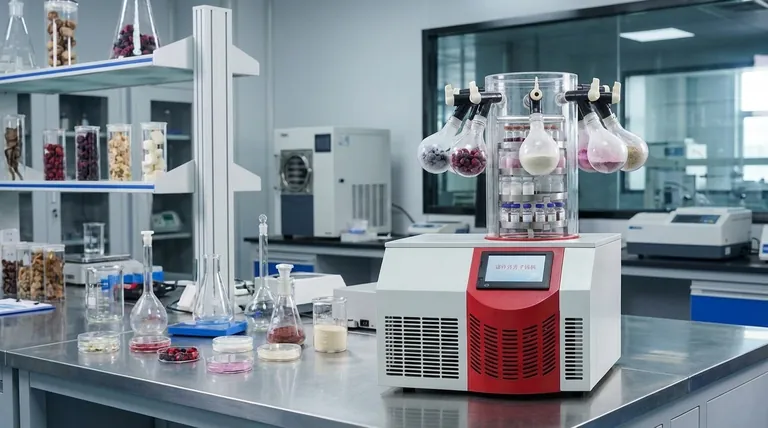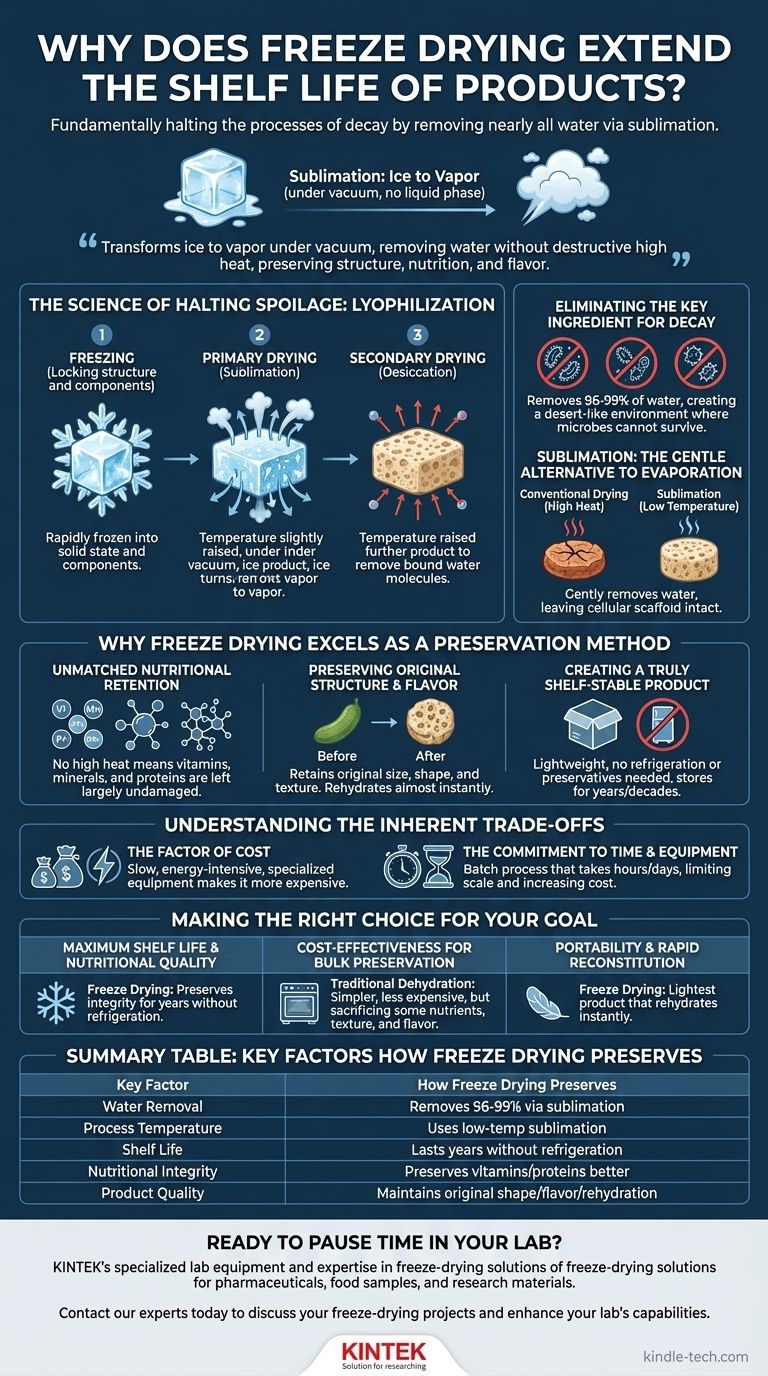Freeze drying fundamentally halts the processes of decay. It achieves this by removing nearly all water from a product through a process called sublimation. Without water, the microorganisms like bacteria and mold that cause spoilage cannot grow or function, and the enzymatic reactions that degrade the product are effectively stopped.
By transforming ice directly into vapor under a vacuum, freeze drying removes water without the destructive high heat of conventional drying. This unique process not only halts spoilage but also preserves the product's original structure, nutrition, and flavor with remarkable fidelity.

The Science of Halting Spoilage: Lyophilization
Lyophilization, the technical term for freeze drying, is a deliberate, multi-stage process designed for maximum preservation. It targets the single most critical element required for decomposition: water.
Eliminating the Key Ingredient for Decay
Nearly all biological and chemical processes that lead to spoilage depend on water. Bacteria, yeasts, and molds require moisture to grow and multiply. By removing water to a level of 1-4%, freeze drying creates a desert-like environment where these microbes cannot survive.
The Three-Step Process
The process is methodical, ensuring the product's structure is not damaged.
- Freezing: The product is rapidly frozen to lock its structure and components in place.
- Primary Drying (Sublimation): The product is placed under a deep vacuum, and the temperature is slightly raised. This causes the frozen water (ice) to turn directly into vapor without ever becoming liquid.
- Secondary Drying: The temperature is raised further to remove any remaining "bound" water molecules, ensuring the product is thoroughly desiccated.
Sublimation: The Gentle Alternative to Evaporation
Conventional drying uses heat to evaporate water. This high heat can shrink, crack, and damage a product's delicate structure and destroy heat-sensitive nutrients. Sublimation is a low-temperature process that gently removes water while leaving the product's cellular scaffold perfectly intact.
Why Freeze Drying Excels as a Preservation Method
The benefits of freeze drying extend far beyond simply making a product last longer. The quality of that preservation is what sets it apart.
Unmatched Nutritional Retention
The absence of high heat means that vitamins, minerals, and proteins are left largely undamaged. Freeze-dried foods are significantly more nutritious than those preserved through other dehydration methods that rely on heat, which can degrade these essential compounds.
Preserving Original Structure and Flavor
Because the water is removed from a frozen structure, the product retains its original size, shape, and texture. This creates a porous, sponge-like material that rehydrates almost instantly when water is added, returning to a state remarkably close to its fresh form.
Creating a Truly Shelf-Stable Product
By removing the water, freeze drying creates an exceptionally lightweight product. This product requires no refrigeration or chemical preservatives and can be stored at room temperature for years—or even decades—without degradation, as long as it is protected from moisture and oxygen.
Understanding the Inherent Trade-offs
While highly effective, the sophistication of freeze drying comes with clear trade-offs that are important to understand.
The Factor of Cost
Lyophilization is a slow, energy-intensive process that requires specialized equipment. This makes freeze-dried products significantly more expensive to produce than those preserved by conventional canning or dehydration.
The Commitment to Time and Equipment
Unlike continuous drying methods, freeze drying is a batch process that can take many hours, or even days, to complete. This slower cycle time and the need for high-vacuum chambers limit its scale and contribute to the overall cost.
Making the Right Choice for Your Goal
Selecting a preservation method depends entirely on your priorities for the final product.
- If your primary focus is maximum shelf life and nutritional quality: Freeze drying is the undisputed leader, preserving the product's integrity for years without refrigeration.
- If your primary focus is cost-effectiveness for bulk preservation: Traditional dehydration (air or oven drying) is a simpler, less expensive method, but it comes at the cost of some nutrients, texture, and flavor.
- If your primary focus is portability and rapid reconstitution: Freeze drying provides the lightest possible product that rehydrates almost instantly, making it ideal for applications like instant coffee or backpacking meals.
Ultimately, understanding this process empowers you to see freeze-dried products not merely as preserved, but as paused in time.
Summary Table:
| Key Factor | How Freeze Drying Preserves |
|---|---|
| Water Removal | Removes 96-99% of water via sublimation, halting microbial growth and enzymatic decay. |
| Process Temperature | Uses low-temperature sublimation instead of high heat, protecting delicate structures and nutrients. |
| Shelf Life | Creates a shelf-stable product that can last for years without refrigeration. |
| Nutritional Integrity | Preserves vitamins, minerals, and proteins better than heat-based drying methods. |
| Product Quality | Maintains original shape, flavor, and enables rapid rehydration. |
Ready to Pause Time in Your Lab?
Freeze drying is a sophisticated process that requires precision equipment to achieve optimal results. Whether you are developing pharmaceuticals, preserving food samples, or creating stable research materials, the right lyophilization equipment is critical for success.
KINTEK specializes in providing reliable lab equipment and consumables to meet your laboratory's unique preservation needs. Our expertise can help you select the perfect freeze-drying solution to ensure maximum shelf life, nutritional retention, and product quality for your applications.
Contact our experts today to discuss how we can support your freeze-drying projects and enhance your lab's capabilities.
Visual Guide

Related Products
- Benchtop Laboratory Freeze Dryer for Lab Use
- Laboratory Sterilizer Lab Autoclave Herbal Powder Sterilization Machine for Plant
- Desktop Fast Laboratory Autoclave Sterilizer 35L 50L 90L for Lab Use
- Liquid Nitrogen Cryogenic Grinder Mill Cryomill Airflow Ultrafine Pulverizer
- Touchscreen Automatic Vacuum Heat Press
People Also Ask
- What types of liquid samples can be processed using a laboratory freeze dryer? Preserve Your Sensitive Materials
- Why is freeze drying considered more effective than ordinary drying? Preserve Structure, Nutrients & Flavor
- What role does freeze drying play in scientific research? Preserve Sample Integrity for Reliable Results
- What is the primary function of a freeze dryer in a laboratory setting? Preserve Delicate Materials with Sublimation
- Why are laboratory freeze dryers considered economical tools? Maximize Value and Minimize Loss



















